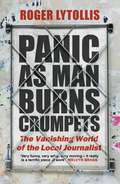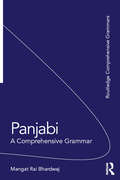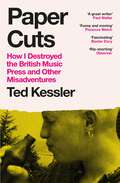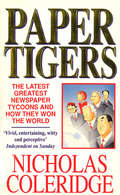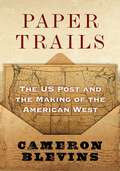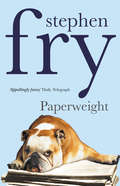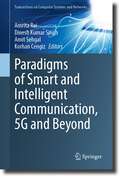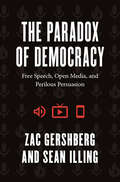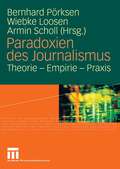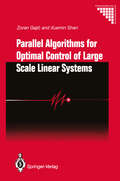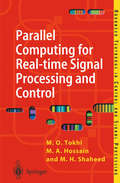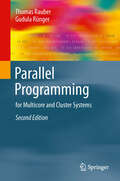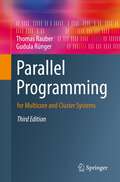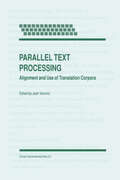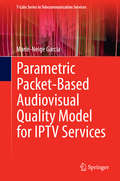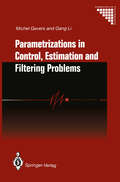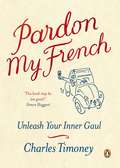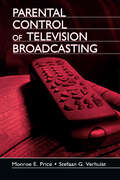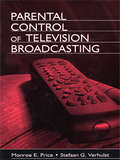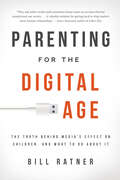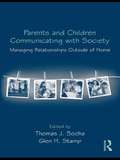- Table View
- List View
Panic as Man Burns Crumpets: The Vanishing World of the Local Journalist
by Roger Lytollis'For those who know about provincial newspapers, this will be a classic and a gem. Those who don't know will envy what they have missed' MELVYN BRAGG'Brisk and entertaining. A very readable love letter to a disappearing world, told with verve and tenderness' STUART MACONIE, author of Pies and Prejudice'Gut-bustingly funny, poignant and packed with astonishing insider information'M. W. CRAVEN, author of the award-winning The Puppet Show'Local publishers . . . need to hold on to thoughtful, dedicated writers such as Roger Lytollis, or his book will be an epitaph to a centuries-old industry'IAN BURRELL, i paperYou dreamed of being a journalist and the dream has come true. You love working for your local paper . . . although not everything is as you imagined.You embarrass yourself with a range of celebrities, from John Hurt to Jordan. Your best story is 'The Man With the Pigeon Tattoo'.A former colleague interviews President Trump. You urinate in the president of the Mothers' Union's garden. Your appearance as a hard-hitting columnist on a BBC talk show does not go well. And being photographed naked is only the second most humiliating thing to happen one infamous afternoon. There are serious stories, such as a mass shooting, a devastating flood, and the search for Madeleine McCann.Meanwhile local papers are dying. Your building is crumbling and your readership is dwindling. Your carefully crafted features are read by fewer people than a story about fancy dress for dogs. Panic as Man Burns Crumpets is the inside story of local newspapers during the past twenty-five years, told in a way that's funny, poignant and revealing.
Panjabi: A Comprehensive Grammar (Routledge Comprehensive Grammars)
by Mangat BhardwajPanjabi: A Comprehensive Grammar is a complete reference guide to Panjabi grammar. It presents a fresh, accessible and thorough description of the language, concentrating on the real patterns of use in modern Panjabi. The book moves from the script and sound through morphology and word classes to a detailed analysis of sentence structures and semantic features. The volume is organized to promote a thorough understanding of Panjabi grammar. It offers a stimulating analysis of the complexities of the language, and provides full and clear explanations. Throughout, the emphasis is on Panjabi as used by present-day native speakers. An extensive index and numbered paragraphs provide readers with easy access to the information they require. Features include: detailed treatment of the common grammatical structures and parts of speech extensive exemplification particular attention to areas of confusion and difficulty Gurmukhi script and transliteration provided throughout additional chapter on the Shahmuki script Panjabi: A Comprehensive Grammar is an essential reference source for the learner and user of Panjabi. With clear and simple explanations it will remain the standard reference work for years to come for both learners and linguists alike. A Workbook and Reader to accompany this grammar can be downloaded from https://www.routledge.com/products/9781138793866. *Please note that, due to unforseen circumstances, the Workbook and Reader have been delayed.*
Paper Cuts: How I Destroyed the British Music Press and Other Misadventures
by Ted Kessler'A great writer' Paul Weller'A music journalist of integrity' Billy Childish'There's only one Ted Kessler!' Liam GallagherPAPER CUTS is the inside story of the slow death of the British music press. But it's also a love letter to it, the tale of how music magazines saved one man's life. Ted Kessler left home and school around his seventeenth birthday, determined 'to be someone who listened to music professionally'. That dream appeared forlorn when he was later arrested for theft behind the counter of the record shop he managed during acid house's long hot summer of love. Paper Cuts tells how Kessler found redemption through music and writing and takes us on a journey alongside the stars he interviewed and the work-place dramas he navigated as a senior staffer at NME through the boom-time '90s and on to the monthly Q in 2004, where he worked for sixteen years before it folded with him at its helm as editor in 2020.We travel in time alongside musical heroes Paul Weller, Kevin Rowland, Mark E Smith, and to Cuba twice, first with Shaun Ryder and Bez, then with Manic Street Preachers. We spend long, mad nights out with Oasis and The Strokes, quality time with Jeff Buckley and Florence Welch, and watch Radiohead deliver cold revenge upon Kessler in public. A story about love and death, about what it's like when a music writer shacks up with a conflict of interest, and what happens when your younger brother starts appearing on the cover of the magazines you work for, this is the memoir of "a delinquent doofus" whose life was both rescued and defined by music magazines.
Paper Tigers
by Nicholas ColeridgePaper Tigers is a riveting, authoritative and in-depth study of newspaper barons of the world – men and women who wield immense power, and whose ever-changing media empires make compelling case studies of business success and failure.From Rupert Murdoch to Robert Maxwell, Conrad Black to Lord Rothermere, Katharine Graham to Punch Sulzberger, Coleridge interviewed them all. The results confirm his status as a devastatingly astute observer of our times, one with few equals today.
Paper Trails: The US Post and the Making of the American West
by Cameron BlevinsA groundbreaking history of how the US Post made the nineteenth-century American West. There were five times as many post offices in the United States in 1899 than there are McDonald's restaurants today. During an era of supposedly limited federal government, the United States operated the most expansive national postal system in the world. In this cutting-edge interpretation of the late nineteenth-century United States, Cameron Blevins argues that the US Post wove together two of the era's defining projects: western expansion and the growth of state power. Between the 1860s and the early 1900s, the western United States underwent a truly dramatic reorganization of people, land, capital, and resources. It had taken Anglo-Americans the better part of two hundred years to occupy the eastern half of the continent, yet they occupied the West within a single generation. As millions of settlers moved into the region, they relied on letters and newspapers, magazines and pamphlets, petitions and money orders to stay connected to the wider world. Paper Trails maps the spread of the US Post using a dataset of more than 100,000 post offices, revealing a new picture of the federal government in the West. The western postal network bore little resemblance to the civil service bureaucracies typically associated with government institutions. Instead, the US Post grafted public mail service onto private businesses, contracting with stagecoach companies to carry the mail and paying local merchants to distribute letters from their stores. These arrangements allowed the US Post to rapidly spin out a vast and ephemeral web of postal infrastructure to thousands of distant places. The postal network's sprawling geography and localized operations forces a reconsideration of the American state, its history, and the ways in which it exercised power.
Paper Trails: The US Post and the Making of the American West
by Cameron BlevinsA groundbreaking history of how the US Post made the nineteenth-century American West. There were five times as many post offices in the United States in 1899 than there are McDonald's restaurants today. During an era of supposedly limited federal government, the United States operated the most expansive national postal system in the world. In this cutting-edge interpretation of the late nineteenth-century United States, Cameron Blevins argues that the US Post wove together two of the era's defining projects: western expansion and the growth of state power. Between the 1860s and the early 1900s, the western United States underwent a truly dramatic reorganization of people, land, capital, and resources. It had taken Anglo-Americans the better part of two hundred years to occupy the eastern half of the continent, yet they occupied the West within a single generation. As millions of settlers moved into the region, they relied on letters and newspapers, magazines and pamphlets, petitions and money orders to stay connected to the wider world. Paper Trails maps the spread of the US Post using a dataset of more than 100,000 post offices, revealing a new picture of the federal government in the West. The western postal network bore little resemblance to the civil service bureaucracies typically associated with government institutions. Instead, the US Post grafted public mail service onto private businesses, contracting with stagecoach companies to carry the mail and paying local merchants to distribute letters from their stores. These arrangements allowed the US Post to rapidly spin out a vast and ephemeral web of postal infrastructure to thousands of distant places. The postal network's sprawling geography and localized operations forces a reconsideration of the American state, its history, and the ways in which it exercised power.
Paperweight
by Stephen FryA delightful compendium of writings that perfectly express the wit and wisdom of Stephen Fry.A hilarious collection of the many articles written by Stephen Fry for magazines, newspapers and radio. It includes selected wireless essays of Donald Trefusis, the ageing professor of philology brought to life in Fry's novel The Liar, and the best of Fry's weekly column for the Daily Telegraph.Perfect to dip into but just as enjoyable to read cover to cover, this book, perhaps more than any other, shows the breadth of Fry's interests and the depth of his insight. He remains a hilarious writer on whatever topic he puts his mind to.
Paradigms of Smart and Intelligent Communication, 5G and Beyond (Transactions on Computer Systems and Networks)
by Amrita Rai Dinesh Kumar Singh Amit Sehgal Korhan CengizThis book focuses on both theory and applications of Artificial Intelligence and Machine Learning in the broad areas of communication and networking. This book focuses on the ongoing research work and future scope for various open research issues related to sustainable design, development, and analysis of smart communication, 5G and beyond, with the integration of Artificial intelligence and IoT. It addresses fundamental technology components for 5G and beyond, which include modern advancements in communication and networking in a real-world application. The book presents the convergence of Artificial Intelligence, Machine Learning, and IoT with 5G and beyond wireless networks to give some ice-breaking solutions in radio resource allocation, network management, and cybersecurity. This book will be a valuable resource for academicians, researchers, and professionals working in artificial intelligence/machine learning and its applications in communication and 5G.
The Paradox of Democracy: Free Speech, Open Media, and Perilous Persuasion
by Zac Gershberg Sean IllingA thought-provoking history of communications that challenges ideas about freedom of speech and democracy. At the heart of democracy lies a contradiction that cannot be resolved, one that has affected free societies since their advent: Though freedom of speech and media has always been a necessary condition of democracy, that very freedom is also its greatest threat. When new forms of communications arrive, they often bolster the practices of democratic politics. But the more accessible the media of a society, the more susceptible that society is to demagoguery, distraction, and spectacle. Tracing the history of media disruption and the various responses to it over time, Zac Gershberg and Sean Illing reveal how these changes have challenged democracy—often with unsettling effects. The Paradox of Democracy captures the deep connection between communication and political culture, from the ancient art of rhetoric and the revolutionary role of newspapers to liberal broadcast media and the toxic misinformation of the digital public sphere. With clear-eyed analysis, Gershberg and Illing show that our contemporary debates over media, populism, and cancel culture are not too different from democratic cultural experiences of the past. As we grapple with a fast-changing, hyper-digital world, they prove democracy is always perched precipitously on a razor’s edge, now as ever before.
The Paradox of Democracy: Free Speech, Open Media, and Perilous Persuasion
by Zac Gershberg Sean IllingA thought-provoking history of communications that challenges ideas about freedom of speech and democracy. At the heart of democracy lies a contradiction that cannot be resolved, one that has affected free societies since their advent: Though freedom of speech and media has always been a necessary condition of democracy, that very freedom is also its greatest threat. When new forms of communications arrive, they often bolster the practices of democratic politics. But the more accessible the media of a society, the more susceptible that society is to demagoguery, distraction, and spectacle. Tracing the history of media disruption and the various responses to it over time, Zac Gershberg and Sean Illing reveal how these changes have challenged democracy—often with unsettling effects. The Paradox of Democracy captures the deep connection between communication and political culture, from the ancient art of rhetoric and the revolutionary role of newspapers to liberal broadcast media and the toxic misinformation of the digital public sphere. With clear-eyed analysis, Gershberg and Illing show that our contemporary debates over media, populism, and cancel culture are not too different from democratic cultural experiences of the past. As we grapple with a fast-changing, hyper-digital world, they prove democracy is always perched precipitously on a razor’s edge, now as ever before.
The Paradox of Democracy: Free Speech, Open Media, and Perilous Persuasion
by Zac Gershberg Sean IllingA thought-provoking history of communications that challenges ideas about freedom of speech and democracy. At the heart of democracy lies a contradiction that cannot be resolved, one that has affected free societies since their advent: Though freedom of speech and media has always been a necessary condition of democracy, that very freedom is also its greatest threat. When new forms of communication arrive, they often bolster the practices of democratic politics. But the more accessible the media of a society, the more susceptible that society is to demagoguery, distraction, and spectacle. Tracing the history of media disruption and the various responses to it over time, Zac Gershberg and Sean Illing reveal how these changes have challenged democracy—often with unsettling effects. The Paradox of Democracy captures the deep connection between communication and political culture, from the ancient art of rhetoric and the revolutionary role of newspapers to liberal broadcast media and the toxic misinformation of the digital public sphere. With clear-eyed analysis, Gershberg and Illing show that our contemporary debates over media, populism, and cancel culture are not too different from the democratic cultural experiences of the past. As we grapple with a fast-changing, hyper-digital world, they prove democracy is always perched precipitously on a razor’s edge, now as ever before.
Paradoxien des Journalismus: Theorie - Empirie - Praxis
by Bernhard Pörksen Wiebke Loosen Armin SchollParallel Algorithms for Optimal Control of Large Scale Linear Systems (Communications and Control Engineering)
by Zoran Gajic Xuemin ShenParallel Algorithms for Optimal Control of Large Scale Linear Systems is a comprehensive presentation for both linear and bilinear systems. The parallel algorithms presented in this book are applicable to a wider class of practical systems than those served by traditional methods for large scale singularly perturbed and weakly coupled systems based on the power-series expansion methods. It is intended for scientists and advance graduate students in electrical engineering and computer science who deal with parallel algorithms and control systems, especially large scale systems. The material presented is both comprehensive and unique.
Parallel Computing for Real-time Signal Processing and Control (Advanced Textbooks in Control and Signal Processing)
by M. Osman Tokhi M. Alamgir Hossain M. Hasan ShaheedThis book introduces the advantages of parallel processing and details how to use it to deal with common signal processing and control algorithms. The text includes examples and end-of-chapter exercises, and case studies to put theoretical concepts into a practical context.
Parallel Programming: for Multicore and Cluster Systems
by Thomas Rauber Gudula RüngerInnovations in hardware architecture, like hyper-threading or multicore processors, mean that parallel computing resources are available for inexpensive desktop computers. In only a few years, many standard software products will be based on concepts of parallel programming implemented on such hardware, and the range of applications will be much broader than that of scientific computing, up to now the main application area for parallel computing.Rauber and Rünger take up these recent developments in processor architecture by giving detailed descriptions of parallel programming techniques that are necessary for developing efficient programs for multicore processors as well as for parallel cluster systems and supercomputers. Their book is structured in three main parts, covering all areas of parallel computing: the architecture of parallel systems, parallel programming models and environments, and the implementation of efficient application algorithms. The emphasis lies on parallel programming techniques needed for different architectures. For this second edition, all chapters have been carefully revised. The chapter on architecture of parallel systems has been updated considerably, with a greater emphasis on the architecture of multicore systems and adding new material on the latest developments in computer architecture. Lastly, a completely new chapter on general-purpose GPUs and the corresponding programming techniques has been added.The main goal of the book is to present parallel programming techniques that can be used in many situations for a broad range of application areas and which enable the reader to develop correct and efficient parallel programs. Many examples and exercises are provided to show how to apply the techniques. The book can be used as both a textbook for students and a reference book for professionals. The material presented has been used for courses in parallel programming at different universities for many years.
Parallel Programming: for Multicore and Cluster Systems
by Thomas Rauber Gudula RüngerThis textbook covers the new development in processor architecture and parallel hardware. It provides detailed descriptions of parallel programming techniques that are necessary for developing efficient programs for multicore processors as well as for parallel cluster systems and supercomputers. The book is structured in three main parts, covering all areas of parallel computing: the architecture of parallel systems, parallel programming models and environments, and the implementation of efficient application algorithms. The emphasis lies on parallel programming techniques needed for different architectures. In particular, this third edition includes an extended update of the chapter on computer architecture and performance analysis taking new developments such as the aspect of energy consumption into consideration. The description of OpenMP has been extended and now also captures the task concept of OpenMP. The chapter on message-passing programming has been extended and updated to include new features of MPI such as extended reduction operations and non-blocking collective communication operations. The chapter on GPU programming also has been updated. All other chapters also have been revised carefully. The main goal of this book is to present parallel programming techniques that can be used in many situations for many application areas and to enable the reader to develop correct and efficient parallel programs. Many example programs and exercises are provided to support this goal and to show how the techniques can be applied to further applications. The book can be used as a textbook for students as well as a reference book for professionals. The material of the book has been used for courses in parallel programming at different universities for many years.
Parallel Text Processing: Alignment and Use of Translation Corpora (Text, Speech and Language Technology #13)
by Jean Véronisl This book evolved from the ARCADE evaluation exercise that started in 1995. The project's goal is to evaluate alignment systems for parallel texts, i. e. , texts accompanied by their translation. Thirteen teams from various places around the world have participated so far and for the first time, some ten to fifteen years after the first alignment techniques were designed, the community has been able to get a clear picture of the behaviour of alignment systems. Several chapters in this book describe the details of competing systems, and the last chapter is devoted to the description of the evaluation protocol and results. The remaining chapters were especially commissioned from researchers who have been major figures in the field in recent years, in an attempt to address a wide range of topics that describe the state of the art in parallel text processing and use. As I recalled in the introduction, the Rosetta stone won eternal fame as the prototype of parallel texts, but such texts are probably almost as old as the invention of writing. Nowadays, parallel texts are electronic, and they are be coming an increasingly important resource for building the natural language processing tools needed in the "multilingual information society" that is cur rently emerging at an incredible speed. Applications are numerous, and they are expanding every day: multilingual lexicography and terminology, machine and human translation, cross-language information retrieval, language learning, etc.
Parametric Packet-based Audiovisual Quality Model for IPTV services (T-Labs Series in Telecommunication Services)
by Marie-Neige GarciaThis volume presents a parametric, packet-based, comprehensive model to measure and predict the audiovisual quality of Internet Protocol Television services as it is likely to be perceived by the user. The comprehensive model is divided into three sub-models referred to as the audio model, the video model, and the audiovisual model. The audio and video models take as input a parametric description of the audiovisual processing path, and deliver distinct estimates for both the audio and video quality. These distinct estimates are eventually used as input data for the audiovisual model. This model provides an overall estimate of the perceived audiovisual quality in total. The parametric description can be used as diagnostic information. The quality estimates and diagnostic information can be practically applied to enhance network deployment and operations. Two applications come to mind in particular: Network planning and network service quality monitoring. The audio model can be used indifferently for both applications. However, two variants of the video model have been developed in order to address particular needs of the applications mentioned above. The comprehensive model covers effects due to resolution, coding, and IP-packet loss in case of RTP-type transport. The model applied to quality monitoring is standardized under the ITU-T Recommendations P.1201 and P.1201.2.
Parametrizations in Control, Estimation and Filtering Problems: Accuracy Aspects (Communications and Control Engineering)
by Michel Gevers Gang LiThis book is all about finite wordlength errors in digital filters, con trollers and estimators, and how to minimize the deleterious effects of these errors on the performance of these devices. This does by no means imply that all about finite wordlength errors in filters, controllers and estimators is to be found in this book. We first ventured into the world of finite wordlength effects in 1987 when Gang Li began his PhD thesis in this area. Our more experienced readers might well say 'This shows', but we believe that the extent of our new contributions largely offsets our relative inexperience about the subject that might surface here and there in the book. Our naive view on the subject of finite wordlength errors in 1987 could probably be summarized as follows: • numerical errors due to finite wordlength encoding and roundoff are something that one has to live with, and there is probably not much that can be done about them except to increase the wordlength by improvements on the hardware; • these errors are as old as finite arithmetic and numerical analysis and they must therefore be well understood by now; • thus, if something can be done to minimize their effects, it must have been analysed and put into practice a long time ago. It is almost fair to say that we were wrong on all counts.
Parasitic Antenna Arrays for Wireless MIMO Systems
by Antonis Kalis Athanasios G. Kanatas Constantinos B. PapadiasThis book unites two different technologies: parasitic antenna arrays driven via analogue circuits that control the electromagnetic waves generated by the antenna array; and MIMO technology for multi-antenna arrays, typically driven by digital techniques in the baseband domain. The combination of these two technologies has revealed a novel functionality that breaks through the conventional MIMO paradigm, allowing MIMO transmission over the air with the use of antenna arrays that may consist of only a single active element, that is surrounded by a number of passive neighboring antennas. The contributions in the book show the capability of such systems to also perform MIMO transmission. This fact holds the potential of revolutionizing the way small-form wireless terminals operate and seems to set the scene for a win-win situation, achieving MIMO transmission with very small and cheap antenna arrays. The book is structured to provide a well-rounded treatment of the various facets of this newly discovered wireless communication capability. All relevant technical angles, ranging from information theoretic to electromagnetic considerations; from analogue circuit to digital baseband control for signal generation; and from channel modeling to communication theoretic aspects are taken into account. A good balance between theory, practical considerations and over-the-air experimentation is proposed and reflected in the chapter outline. Finally, a discussion and early evidence related to potential applications as well as the relevance to current and upcoming wireless standards is provided.
Pardon My French: Unleash Your Inner Gaul
by Charles TimoneyTHINGS YOU DIDN'T KNOW ABOUT FRANCE: You burnt Joan of Arc! ? Smuggling live chickens into rugby matches is patriotic ? How many times to kiss on the cheek ? Where not to cross the road ? French guns don't go 'bang' ? What do you call a party? ? bon appetit is vulgar ? A six-pack is a bar of chocolate ? The dangers of being called Peter or Penny ? Your smallest finger is your 'ear' finger ? The importance of Wednesdays ? How to tip ? and when to celebrate Christmas? Forget the French you learnt at school. Based on twenty years of hard-won knowledge, Pardon My French takes you through all the words you need to survive, shows how and why they work, and steers you past all the pitfalls and potential embarrassments of speaking French in France. From sugar-cube etiquette to why the Marseillaise is all about slaughtering Austrians and Prussians as bloodily as possible, Charles Timoney lays bare the Gallic mindset alongside their bizarre language. Covering all areas of everyday life from eating and drinking to travel, work and, crucially, swearing and sounding like a teenager, this is not just the most entertaining, but also the most useful book on France and the French you'll ever read.
Parental Control of Television Broadcasting (Routledge Communication Series)
by Monroe E. Price Stefaan VerhulstThis project, originally developed for the European Community, examines parental roles in controlling television programs watched by children in Europe. The structure of the study includes: *an analysis of the technical devices available to assist in parental control of television broadcasting services, including descriptions of devices, their cost, availability, and the infrastructure needed to introduce them; *a corresponding analysis of potential ratings or labeling systems to work in conjunction with or in the place of technical devices, enabling a comparative analysis of rating systems used in film, video, and online services; and *an overview and assessment of the educational and awareness measures in the field of protection of minors and harmful content, providing the data for the review of available considerations in this field of viewer literacy. In addition to these main strands of analysis, the study provides for background information and analysis in the following areas: *an overview of the main media theories focusing on the effect and impact of specific types of content on children and their behavior; *an assessment of the economic impact and social efficacy of different protective measures; and *a comparison of the regulatory contexts and rating systems for film, video, television, and online services concerning the protection of minors from harmful content. This volume is intended for scholars and students in comparative media studies, media policy, and regulation.
Parental Control of Television Broadcasting (Routledge Communication Series)
by Monroe E. Price Stefaan VerhulstThis project, originally developed for the European Community, examines parental roles in controlling television programs watched by children in Europe. The structure of the study includes: *an analysis of the technical devices available to assist in parental control of television broadcasting services, including descriptions of devices, their cost, availability, and the infrastructure needed to introduce them; *a corresponding analysis of potential ratings or labeling systems to work in conjunction with or in the place of technical devices, enabling a comparative analysis of rating systems used in film, video, and online services; and *an overview and assessment of the educational and awareness measures in the field of protection of minors and harmful content, providing the data for the review of available considerations in this field of viewer literacy. In addition to these main strands of analysis, the study provides for background information and analysis in the following areas: *an overview of the main media theories focusing on the effect and impact of specific types of content on children and their behavior; *an assessment of the economic impact and social efficacy of different protective measures; and *a comparison of the regulatory contexts and rating systems for film, video, television, and online services concerning the protection of minors from harmful content. This volume is intended for scholars and students in comparative media studies, media policy, and regulation.
Parenting for the Digital Age: The Truth Behind Media's Effect on Children and What to Do About It
by Bill RatnerMalin Akerman's at-home parenting read (Buzzfeed)! Bill Ratner, a long-time Hollywood insider and voice of their movie trailers, explores with in-depth research the change in advertising since 1982 and what children are currently exposed to. As a parent, educator, and veteran insider to the world of television, movies, and new media, Ratner talks openly about the problems associated with excessive screen time, children's advertising, and what parents can do about it.
Parents and Children Communicating with Society: Managing Relationships Outside of the Home (Routledge Communication Series)
by Thomas J. Socha Glen StampThe volume opens a new frontier in parent-child communication research as it brings together veteran researchers and newcomers to explore the communication of parents and children as they create relationships outside the family. The chapters herein examine communication processes and problems of parents and children as they interact with childcare, healthcare, education, and youth sports; investigate the unique challenges facing various types of families as they communicate outside the family (e.g., stepfamilies and gay/lesbian/bisexual families); and consider the role of media in family relationships outside of home. The primary audiences for the volume includes scholars, researchers and graduate students studying communication in families, children’s communication, communication in personal relationships, organizational communication, group communication, and health communication. It will also be of interest to psychologists who study families, children, and organizations; sociologists who study families, children, and organizations; education researchers; teachers; coaches; family physicians; and family therapists. graduate students It has the potential for use in courses in family communication, family studies, family sociology, and child development.
